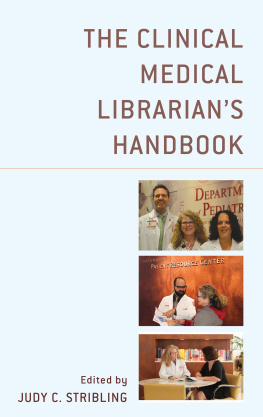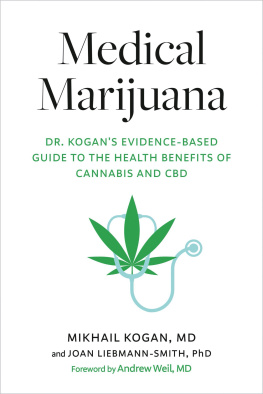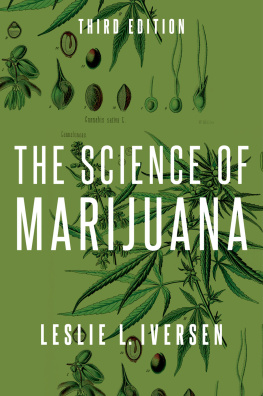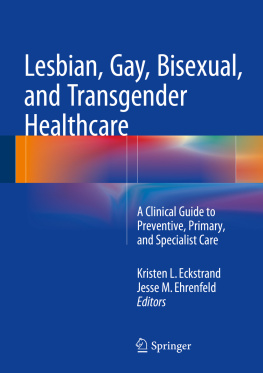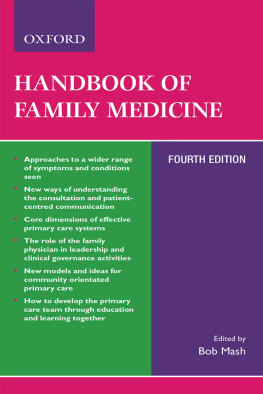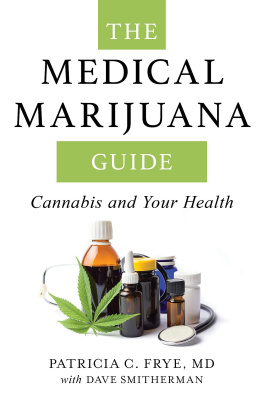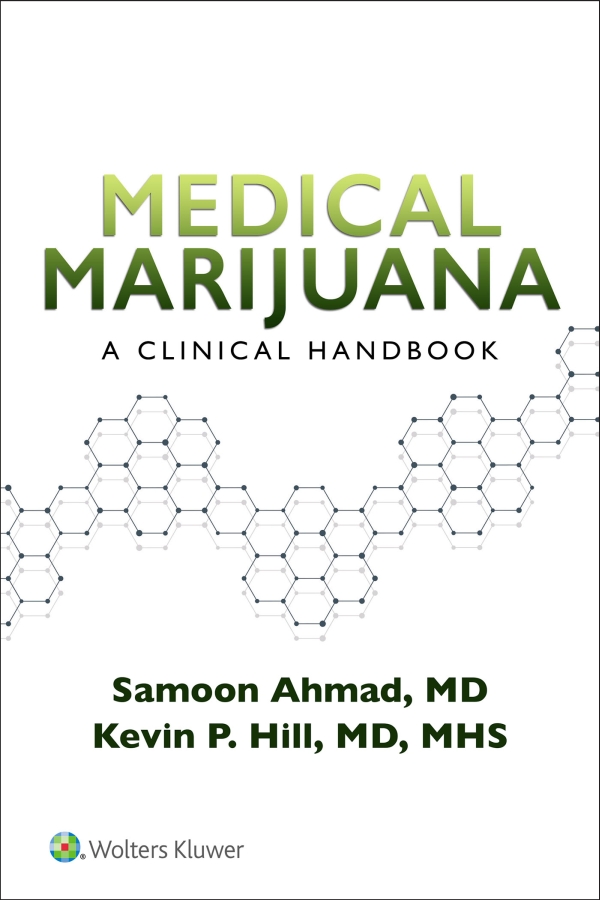Contents
Guide
Pages
MEDICAL
MARIJUANA
A CLINICAL HANDBOOK
MEDICAL
MARIJUANA
A CLINICAL HANDBOOK
First Edition
Samoon Ahmad , MD
Professor of Psychiatry
Department of Psychiatry
New York University Grossman School of Medicine
Attending Physician and Unit Chief Inpatient Psychiatry
Bellevue Hospital Center
New York, New York
Kevin P. Hill , MD, MHS
Director, Division of Addiction Psychiatry
Beth Israel Deaconess Medical Center
Associate Professor of Psychiatry
Harvard Medical School
Boston, Massachusetts

Acquisitions Editor: Chris Teja
Development Editor: Ariel S. Winter
Editorial Coordinator: Chester Anthony Gonzalez
Editorial Assistant: Brian Convery
Marketing Manager: Phyllis Hitner
Production Project Manager: Kim Cox
Design Coordinator: Holly McLaughlin
Manufacturing Coordinator: Beth Welsh
Prepress Vendor: SPi Global
Copyright 2021 Wolters Kluwer
All rights reserved. This book is protected by copyright. No part of this book may be reproduced or transmitted in any form or by any means, including as photocopies or scanned-in or other electronic copies, or utilized by any information storage and retrieval system without written permission from the copyright owner, except for brief quotations embodied in critical articles and reviews. Materials appearing in this book prepared by individuals as part of their official duties as U.S. government employees are not covered by the above-mentioned copyright. To request permission, please contact Wolters Kluwer at Two Commerce Square, 2001 Market Street, Philadelphia, PA 19103, via email at (products and services).
9 8 7 6 5 4 3 2 1
Printed in China
Cataloging-in-Publication Data available on request from the Publisher
ISBN: 978-1-9751-4189-9
This work is provided as is, and the publisher disclaims any and all warranties, express or implied, including any warranties as to accuracy, comprehensiveness, or currency of the content of this work.
This work is no substitute for individual patient assessment based upon healthcare professionals examination of each patient and consideration of, among other things, age, weight, gender, current or prior medical conditions, medication history, laboratory data and other factors unique to the patient. The publisher does not provide medical advice or guidance and this work is merely a reference tool. Healthcare professionals, and not the publisher, are solely responsible for the use of this work including all medical judgments and for any resulting diagnosis and treatments.
Given continuous, rapid advances in medical science and health information, independent professional verification of medical diagnoses, indications, appropriate pharmaceutical selections and dosages, and treatment options should be made and healthcare professionals should consult a variety of sources. When prescribing medication, healthcare professionals are advised to consult the product information sheet (the manufacturers package insert) accompanying each drug to verify, among other things, conditions of use, warnings and side effects and identify any changes in dosage schedule or contraindications, particularly if the medication to be administered is new, infrequently used or has a narrow therapeutic range. To the maximum extent permitted under applicable law, no responsibility is assumed by the publisher for any injury and/or damage to persons or property, as a matter of products liability, negligence law or otherwise, or from any reference to or use by any person of this work.
shop.lww.com
Dedicated to my wife, Kim, and son, Daniel.
S.A.
Dedicated to my parents, Anne and Larry Hill, for making sacrifices so that I could pursue my dreams.
K.P.H.
Foreword
D rs. Samoon Ahmad and Kevin P. Hillthe former a Professor of Psychiatry at NYU and the latter an Associate Professor of Psychiatry at Harvardhave written a comprehensive treatise on cannabis, more commonly known as marijuana or alternatively, marihuana. It is a book that is long overdue.
The authors, an outstanding clinical psychiatrist and an addiction specialist, do much to dispel the myths and misunderstandings about cannabis, which is primarily a recreational drug but has recently been shown to have profound therapeutic effects for a great variety of medical and psychiatric disorders. Its medical use has not been available because of the many laws that prevent practitioners from prescribing it.
For example, in the United States, marijuana is an illegal drug at the federal level because of the Controlled Substance Act of 1970. Despite this, more than 33 states have created medical marijuana programs in which specially trained practitioners can recommend cannabis. Of these, 11 states also allow marijuana to be used as a recreational substance as well. Clearly, the tide is turning; however, the potential for conflict between state and federal laws is not yet resolved. One can only hope that books like this provide a path for the federal government to lift the draconian laws that prohibit its medical use.
The book opens with a chapter that introduces the reader to the history of cannabis and describes its use as a medicine throughout the ages with specific references to its use in China over 6000 years ago. There is also a chapter on the thorny issue of classification, which provides an overview of the different types of cannabis found throughout the world. The book also includes a chapter that describes more than 120 compounds that are found in the plant. The enormous number of compounds found in cannabis clearly accounts for the confusion about its effects on the mind and body.
The legal aspects surrounding cannabis mentioned above are discussed extensively in a chapter on the regulation of cannabis in this country. The rules have changed so much over the yearsand continue to do sothat the authors suggest the reader stay up-to-date on a special Web site associated with the book that will chronicle not only these legal aspects but also the rapidly expanding medical knowledge about cannabis itself.
A large portion of the text deals with the pharmacology of cannabis, which the authors describe as shrouded in mystery. They do an excellent job solving that mystery in a series of chapters that discuss principles of pharmacology in general and of cannabis in particular. The reader will gain an understanding of pharmacodynamics, pharmacokinetics, absorption, distribution, and other data, including the molecular action of the many drugs derived from the parent plant, including illustrations of chemical formulas.
At the heart of the book is a detailed exposition of each of the approved cannabis-based drugs: dronabinol, nabilone, and cannabidiol. The authors discuss these three drugs and provide extensive data, including specific dosages, preparations, routes of administration, and side effects. They are careful to differentiate approved therapeutic indications from off-label use, the latter accounting for improvement in several conditions otherwise resistant to therapy. Importantly, adverse effects and drug-drug interaction are discussed extensively throughout.
A unique aspect of the text is 12 chapters that are organized according to organ systems that provide a template for disorders for which cannabis might be of help. The chapter titles explain which drugs can be used in which disorders. They are easily understood and uniquely organized: gynecology, dermatology, rheumatology, ophthalmology, oncology, and internal medicine, among others. It is an impressive list.


